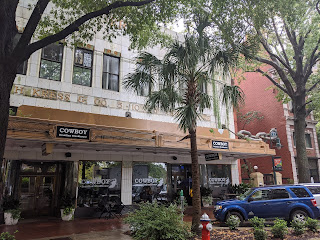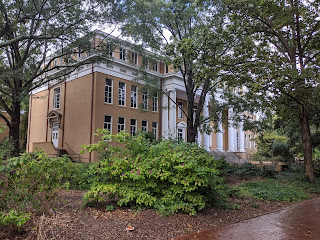Steven and I had arrived the previous day in South Carolina's capital city of Columbia too late in the day to see any of the city center or tour the capitol building. That was why we devoted the next mid-September day to do both. We started with the Trinity Episcopal Church that was organized in 1812 with the present church built in 1848. In the churchyard were buried a notable poet, US senator, five state governors, and soldiers from the Revolutionary and later American wars.
This Daily Travelogue is a labor of love for our families and friends at home and around the world. Prior to 2020, all our trips were documented on separate, yearly blogs which can be accessed below. Remember that clicking on any picture will open it for better viewing. Also, please consider adding your name at the end of any comments. Be safe, stay healthy, and stay connected.
Wednesday, May 5, 2021
9/17/20: Charming Columbia, South Carolina
The Trinity Parish House was constructed in 1924.
When Columbia was founded in 1786, the city replaced Charleston (perhaps our favorite Southern city!) as the state capital because 'upstaters' didn't want to spend two weeks traveling to the coastal city. The first statehouse or capitol was a small wooden building built in 1789 just west of the current site. Construction of the current building began in 1855 but work had to be suspended in 1863 during the Civil War. Union troops burned the old statehouse in 1865 and shelled the blue granite walls of the unfinished building, raising the US flag over it.
Because the columns on the porticos were each carved from just one piece of stone, they were believed to be the largest monolithic columns of any public building in the country.
This was one of the six bronze stars that marked the spots on the capitol struck by General William Sherman's Union Army cannonballs during the Civil War.
During the occupation of Columbia by Sherman in 1865, soldiers broke off the cane's lower part on the George Washington statue that had honored the country's first president. The statue stood 6'2.5" tall as it had been modeled from life.
The capitol's interior floors were of pink Tennessee and white Georgia marble. The columns were each made from one piece of blue granite, the state stone. We learned that there were seismic indicators under the capitol because Columbia was prone to earthquake activity.
We had to look very closely at the original arched ceiling to observe it had been made of brick.
In the lower lobby was The Angel of Marye's Heights painting depicting Confederate soldier Richard Kirkland who risked his life to share water with wounded enemy troops during the 1862 Battle of Fredericksburg.
The Main Lobby was one of the most beautiful of any state capitol we'd yet viewed with its grand wrought-iron railing and collection of paintings, plaques, and statues that reflected the state's history. It looked more like a very, very large, and tastefully decorated home than a statehouse. Like other antebellum statehouses, South Carolina's was designed in the shape of a cross so that both the Senate and House would each have their own wing.
Just outside the Senate was the Battle of Cowpens painting that was one of the first works to depict a Black American in a Revolutionary War battle. We learned that South Carolina saw more battles during that war than any other state.
The decoration on the staircase banister was of the yellow jessamine, the state flower.
The impressive desk in the center of the House of Representatives was of British Honduran mahogany and dated from 1937.
We had a bird's eye view of the attractive main lobby from the second floor.
I'm a sucker for stained glass windows so was very partial to the one on the second floor.
Nearby was a statue of former governor and Civil War General Wade Hampton astride his horse. Palmetto trees lined the adjacent sidewalk.
The City of Columbia Bicentennial Time Capsule had been placed underneath the monument in 1986 to be opened in 2036 on Columbia's 250th anniversary. I would have been curious to know what items had been placed in the capsule for the future generation to learn about Columbia.
The Law Enforcement Monument honored all South Carolina corrections officers who had died in the line of duty. The five granite panels included the names of those slain.
A close-up view of the copper exterior dome:
From the capital we walked just a couple of blocks downtown as the city's Art Deco architecture appealed to us. In what still turned out to be the early days of the pandemic, it was reassuring to read Maya Angelou's words on the Nickelodeon "Every storm runs out of rain.'
We spent some time in the Mast General Store located on Main Street and that was listed on the National Register of Historic Places. The Columbia branch had been thriving since America's Reconstruction period and still had its original pressed-tin ceiling. It was fun looking at the over 500 old-fashioned varieties of candies and the appealing handicrafts from throughout South and North Carolina.
Historic posters along the street told of the state's and city's battle with civil rights during the 1960s. I read that of the hundreds of sit-in cases that were prosecuted nationally, the US Supreme Court heard 17, four of which were from South Carolina. The Court's decisions helped ensure the passage of the 1964 Civil Rights Act.
Seeing the massive chain links that connected two buildings across the street caught our attention. I didn't know if it may have referred to the slaves brought over from Africa, the city's civil rights history, or had another meaning.
This was one of the most beautiful clocks we'd ever seen in public.
The HOPE for Columbia artwork was designed to be "A sign of hope, a message of positivity, for the bright future of the Columbia community as we join together, better, and stronger than ever." The sign incorporated the colors of the city's flag.
If you ever are curious to know about the legendary Southern charm and hospitality, all you need to do is to head to Columbia! I can't tell you the number of times people stopped us to ask if they could help us find anything or just welcomed us to their city.
In 1960, two African American college students led a protest march to the Eckerd's luncheonette. They were refused service because of their race, then jailed and convicted for refusing to leave their seats. However, a Supreme Court decision overturned their convictions. Their sit-in was part of the protest movements against racial segregation in Columbia and elsewhere.
The Governor's Mansion was located in the former Arsenal Academy, a state arsenal whose buildings had been burned by Union troops except for the officers quarters during the Civil War.
Just two blocks from the Governor's mansion, both Steven and I were totally surprised on finding a Cemetery of the Columbia Hebrew Benevolent Society in this Southern city. Many distinguished Jewish citizens, including two mayors, were buried in the cemetery that was organized in 1922 and chartered in 1934.
Never before had we seen a memorial to those who perished at Pearl Harbor except in Hawaii.
The park also featured a Holocaust Monument that stood on a granite Star of David and displayed the names of Holocaust liberators and survivors from South Carolina engraved on its granite walls.
The memorial included a map of the death and concentration camps across Europe where the Nazis implemented the murder of six million Jews as part of their Final Solution.
We then headed over to the Seaboard Air Line Railway Passenger Depot that was built in 1904 and was the third passenger depot built in Columbia. The depot served passengers on the Atlantic Coast Line Railroad and the Southern Railway. The depot had also been listed in the National Register of Historic Places and was part of the West Gervais Street Historic District.
The historic district was a fun, fun area with lots of independent restaurants and shops which would have been a delight to peruse if it hadn't been near the end of the day.
The negative space in the Body in Spirit sculpture captured "that which is seen through it, thereby visually filling the void with what surrounds the sculpture."
South of downtown was the University of South Carolina (USC) that had been chartered in 1801 and still played a prominent role in the life of the capital city. These trees were planted in memory of the USC students and alumni who gave their lives on the Mexican border and in the world from 1916-1918.
It was fun wandering then around the USC campus which just oozed charm.
A banner proclaimed that Columbia had been designated as the number three college town in the country by some organization. I would have had a tough time disputing that accolade as Columbia thoroughly charmed me.
Next post: Columbia's colorful murals that we saw while in between touring some of the sights in the above post.
Posted on May 5th, 2021, from Denver where the sun has been trying to make its presence felt even though we've had the rainiest spring since the 1940s! I hope life is sunnier in every respect for you and your loved ones as you still cope with the pandemic.
Subscribe to:
Post Comments (Atom)



































































































What beautiful photos of the number three college town in the country (what are numbers 1 and two.. Berkley, Cambridge ??). As always thank you for the wonderful tour and informative history lesson of another lovely state capital.. what is your favourite so far ?
ReplyDeletexo Lina xo
Lina,
ReplyDeleteGood question about which is our favorite state capital and capitol so far. I was really impressed with Columbia in both respects so would rate it near the top. Salem in Oregon was also delightful with its unusual capitol architecture.
We'll be stopping at a lot more capital cities when we embark on our summer road trip in early June so will be curious to see how the capitols in the Northeast compare to those we've already toured in the West and South.
XOXO